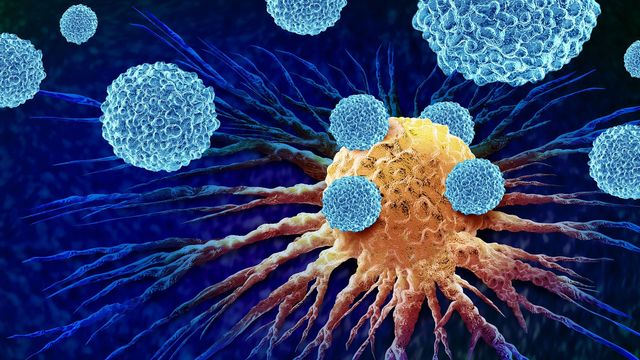Thank you. Listen to this article using the player above. ✖
Want to listen to this article for FREE?
Complete the form below to unlock access to ALL audio articles.
In a discovery that could expand the array of current cancer immunotherapy treatments, scientists at Harvard Medical School have identified a new molecular brake that hinders the ability of T cells to attack tumors.
The research, published Aug. 12 in Nature Immunology and supported in part by federal funding, offers a new pathway to design treatments that help more patients — a welcome development given that current cancer immunotherapies work in less than half of those who receive them.
The research, done in mice and in human cells, shows that a protein called STUB1 restrains the immune system’s elite cancer-fighting CD8+ T cells. It does so by interfering with immune-signaling receptors — particularly one for the molecule IL-27 — that are crucial for T cells’ ability to mount a vigorous anti-tumor response.
Blocking STUB1, the researchers said, could lead to new ways to supercharge cancer immunotherapies.
“Even though cancer immunotherapies have transformed the way we treat cancer, it’s important that we find new ways to extend the lifesaving and lifechanging benefits of these therapies to more people,” said lead author Martin LaFleur, a postdoctoral researcher in the lab of Arlene Sharpe, the Kolokotrones University Professor in the Blavatnik Institute at HMS, a pioneer in cancer immunotherapy, and senior author on the work. “We believe our work and CRISPR screens more broadly are critical for identifying and prioritizing possible therapeutic targets to find the best ones for patients.”
What the researchers found
Using the gene-editing tool CRISPR, the researchers screened nearly 900 genes to see which ones might be preventing the CD8+ T cells from attacking tumors effectively. One gene stood out: STUB1. When the researchers deleted this gene in CD8+ T cells, these cells became markedly better at attacking tumors. Mice with STUB1-deficient T cells had slower-growing cancers and lived longer than those with unaltered T cells.
The experiments showed that STUB1 works by dialing down the ability of T cells to detect and respond to signals from immune-boosting molecules called cytokines. STUB1 does so by engaging with another protein called CHIC2, the study found. When STUB1-CHIC2 interact, they remove key receptors from the surface of T cells, rendering these immune defenders less responsive to immune-activating signals sent by cytokines. The findings suggest that blocking the interplay between STUB1-CHIC2 could strengthen the body’s natural responses against cancer and inform the design of new treatments.
How the findings can inform next-generation cancer therapies
Even though the work was done mainly in mice, the researchers say there are telltale signs that the same process might be at play in humans. A separate set of experiments showed that removing STUB1 or CHIC2 in human T cells led to increased levels of cytokine receptors, consistent with their observations in mice. And, notably, a recent study found that IL-27 is linked with improved killer T-cell and immunotherapy responses in human patients. This leads the researchers to believe that inhibition of STUB1 may boost IL-27 signaling and enhance tumor immunity in humans.
The discovery could lead to a drug — an avenue the research team is currently pursuing — but it could also enable cell-based approaches. For example, engineering T cells without STUB1 may be a promising strategy, especially given that STUB1 is broadly expressed and selectively removing it from T cells would enhance their function while minimizing the risk of potential toxicities that could result from systemic inhibition.
Additionally, the findings can help fill two important gaps in cancer immunotherapy.
First, scientists do not know all the crucial signals that give a T cell the go-ahead to mount a potent anti-tumor response. The results of the new study show that STUB1 inhibits cytokine signaling during early T-cell responses and highlights the cytokine IL-27 as an important signal in the priming of T cells.
Second, researchers said, blocking STUB1 is a tantalizing therapeutic approach because it works on two fronts: enhancing T cells’ anti-tumor responses while also rendering tumors more vulnerable to killing by T cells.
“We anticipate that STUB1 inhibition could be effective as either as a monotherapy or with existing cancer treatments,” LaFleur said. “Given that STUB1 influences early T-cell priming, it may be an effective combination therapy with other treatments that work later in the T-cell response.”
The researchers emphasize that further studies are needed to fully understand the promise, effectiveness, and safety of STUB1 inhibition in humans. But the findings provide valuable new insights into how the immune system fights cancer and how scientists might help it do so more efficiently.
Reference: LaFleur MW, Milling LE, Prathima P, et al. A STUB1–CHIC2 complex inhibits CD8+ T cells to restrain tumor immunity. Nat Immunol. 2025. doi: 10.1038/s41590-025-02231-6
This article has been republished from the following materials. Note: material may have been edited for length and content. For further information, please contact the cited source. Our press release publishing policy can be accessed here.
